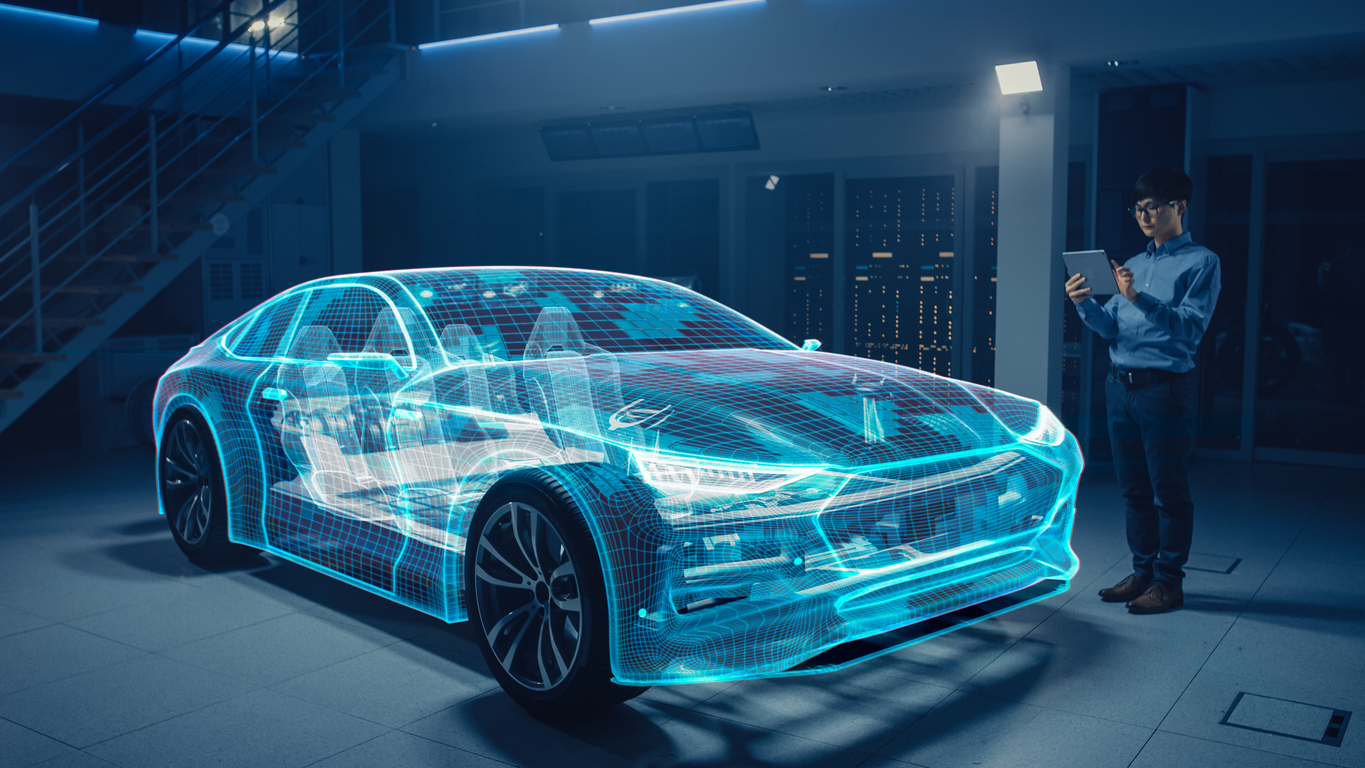What’s Trending in Automotive Software Development?
The automotive industry is at a pivotal crossroads, driven by rapid advancements in software technology. From enhancing vehicle functionality to revolutionizing user experiences, cutting-edge software is reshaping how we interact with our vehicles and the road itself.
This blog delves into the key trends in custom software development for the automotive industry, spotlighting the groundbreaking technologies that are shaping both the current market and its future trajectory.
1. AI & Machine Learning in Automotive Software

Artificial Intelligence (AI) and Machine Learning (ML) are revolutionizing the automotive industry by enhancing software functionalities and creating smarter, more adaptive vehicles.
These technologies enable vehicles to learn from vast amounts of data and make intelligent decisions, from optimizing driving patterns to enhancing safety features.
AI and ML are being applied in several critical areas within automotive software development.
Advanced Driver Assistance Systems (ADAS)
Beyond basic functionalities, AI is integral in developing more advanced ADAS features like adaptive cruise control, lane-keeping assistance, and advanced parking guidance systems. These features use real-time data processing and machine learning to adapt and respond to dynamic road conditions, significantly improving driver safety.
Voice-Activated Controls and Personalization
AI enables more sophisticated voice-recognition technologies, allowing drivers to control various aspects of their vehicles through voice commands. AI algorithms can personalize the driving experience, adjusting settings such as seat positions, climate control, and even driving modes to individual preferences learned over time.
Supply Chain Optimization
AI and ML are not limited to vehicle functionalities but are also revolutionizing the automotive supply chain. AI helps automotive manufacturers optimize their inventory levels, reduce costs, and improve production efficiency by predicting demands and identifying potential supply chain disruptions.
Manufacturing Quality Control
AI systems are increasingly used in manufacturing to detect defects and inconsistencies that human inspectors might miss. By analyzing images from the assembly line in real time, these systems ensure higher quality standards and reduce the need for costly recalls.
Smart Infotainment Systems
AI-driven infotainment systems not only provide navigation and media playback but also learn from user preferences to suggest routes, media, and even nearby points of interest. These systems are becoming central hubs for in-vehicle entertainment and information.
Predictive Maintenance
Machine learning algorithms analyze data from vehicle sensors to predict potential failures before they occur. This proactive approach to maintenance extends the vehicle’s life, saves money, and improves safety.
2. The Rise of Autonomous & Connected Vehicles

The automotive industry is witnessing a significant transformation with the rise of autonomous and connected vehicles powered by sophisticated software development.
Advances in sensors, machine learning, and data analytics have enabled cars to perceive their environment and make decisions with minimal human intervention.
Connected vehicles further enhance this capability by using the internet to communicate with other vehicles, traffic management systems, and infrastructures, creating a more integrated and intelligent transportation network.
Challenges in This Area
Despite the promise of autonomous and connected vehicles, several challenges must be addressed to ensure their successful integration.
- Software Complexity: The software that powers autonomous and connected vehicles is incredibly complex, integrating multiple advanced technologies such as AI, cybersecurity, and cloud computing. Managing this complexity while ensuring the software is robust and error-free is a major challenge.
- Data Management Needs: Autonomous vehicles generate massive amounts of data from sensors like LIDAR, cameras, and radar. Effectively capturing, processing, storing, and analyzing this data in real time presents significant logistical and technical challenges.
- Safety Concerns: The safety of autonomous vehicles remains a primary concern. It is crucial to ensure these vehicles can handle all driving situations safely, especially in unpredictable environments and during hardware or software failures. Additionally, protecting connected vehicles from cybersecurity threats is vital to prevent malicious attacks that could endanger passenger safety.
What Does the Future Look Like?
Looking ahead, the technology behind autonomous and connected vehicles is expected to advance further, leading to greater adoption and integration into daily transportation.
Wider Adoption
As technology matures and regulatory frameworks become clearer, we can expect broader adoption of autonomous and connected vehicles. Public perception will likely shift as more people experience the benefits of these technologies firsthand.
Smart City Integration
Autonomous and connected vehicles will increasingly integrate with smart city infrastructures, leading to more efficient traffic management, reduced congestion, and lower emissions.
Advancements in Vehicle-to-Everything (V2X) Communication
Future developments are likely to enhance V2X communication, allowing vehicles to interact seamlessly with traffic systems, pedestrians, and other vehicles to improve safety and driving efficiency.
3. Telematics & Real-Time Data Utilization

Telematics is a transformative technology in the automotive industry that merges telecommunications and informatics to provide real-time data analytics directly from vehicles.
By utilizing GPS systems, onboard diagnostics (OBD), and mobile internet, telematics enables the transmission of vast amounts of data, offering unprecedented insights into vehicle operation and driver behavior.
Applications & Benefits of Telematics in Automotive Solutions
Telematics is employed in several key applications that enhance both vehicle performance and the driving experience.
- Route Optimization: Telematics systems use real-time traffic data and advanced algorithms to recommend the most efficient routes for drivers, reducing travel time and fuel consumption.
- Maintenance Alerts: Telematics can monitor vehicle diagnostics to predict maintenance needs and alert drivers or fleet managers to potential issues before they become serious problems. This proactive maintenance helps avoid costly repairs and downtime.
- Driver Behavior Monitoring: Telematics devices track how the vehicle is being driven—speeding, hard stops, rapid acceleration—and can provide feedback to help improve driving habits, reduce wear and tear on the vehicle, and lower the risk of accidents.
- Enhanced Safety: Real-time data helps to improve road safety by enabling automatic emergency braking, electronic stability control, and automatic crash notifications that can speed up emergency response times.
- Improved Operational Efficiency: For fleets, telematics can lead to better vehicle management through optimized route planning, reduced idle times, and streamlined reporting, which collectively increase overall operational efficiency.
As connectivity and data analytics advance, the role of telematics in automotive software development is set to become even more central, driving forward innovations that make driving safer, more efficient, and more enjoyable.
4. Shop Management Software

Shop management software is transforming automotive service centers by streamlining operations and enhancing service delivery. This specialized software integrates various functions essential for running a modern automotive repair shop, from booking appointments to handling billing, all within a single platform.
Core Features of Shop Management Software
As automotive technology evolves and customer expectations rise, shop management software offers serious advantages to automotive service centers looking to modernize operations and improve service offerings.
Customer Management
Customer management features allow shops to maintain comprehensive customer profiles, including service history, vehicle details, and communication preferences. It enables personalized service and targeted marketing, enhancing customer engagement.
Inventory Tracking
Effective inventory management is crucial in automotive service centers. Shop management software automates inventory control, helping shops keep track of parts and supplies, predict inventory needs, and reduce waste through better inventory planning.
Service Scheduling
This functionality streamlines the scheduling of repairs and maintenance, allowing for better labor allocation and reduced wait times. Integrated calendars and scheduling tools help maximize shops’ workflow and resources.
Integration Capabilities
Many shop management systems integrate seamlessly with other tools, such as accounting software, email marketing services, and manufacturer databases, creating a cohesive management ecosystem that extends the software’s utility and value.
5. Fleet Management Technology

As businesses seek to optimize their logistical operations and reduce overheads, fleet technology becomes an indispensable tool in their arsenal.
Fleet management software streamlines operations and provides strategic advantages by integrating data insights, real-time monitoring, and predictive analytics.
Fleet Technology Use Cases
Fleet management software is versatile, addressing several critical operational aspects.
- Optimized Routing: Fleet management software can determine the most efficient routes for vehicles using real-time traffic data, GPS tracking, and advanced algorithms. This minimizes delays and reduces fuel consumption, saving costs and improving service delivery times.
- Preventive Maintenance: The software can predict vehicle maintenance needs based on usage patterns and historical data. This proactive approach prevents unexpected breakdowns, extends vehicle lifespans, and maintains safety standards across the fleet.
- Fuel Usage Monitoring: Fleet management software helps identify inefficient practices or unnecessary costs by tracking and analyzing fuel usage. Managers can use this data to implement more fuel-efficient driving protocols or change routes and vehicle loads to reduce overall fuel consumption.
Benefits of Implementing Fleet Management Software |
|
| Cost Savings | Enhanced route planning and maintenance scheduling reduce operational costs directly. Indirect savings come from extending the lifespan of vehicles through better maintenance and reducing fuel consumption through efficient driving practices. |
| Improved Compliance | Fleet management software helps ensure fleets comply with local and international regulations, such as emissions, driving hours, and maintenance records. This is crucial for avoiding fines and maintaining a good operational reputation. |
| Enhanced Fleet Utilization | The software enables businesses to use their vehicles more effectively by providing detailed insights into every aspect of fleet operations. Real-time data helps managers make quick decisions that can adapt to changing circumstances, ensuring that every vehicle is used as efficiently as possible. |
| Increased Safety | Continuous monitoring and maintenance alerts contribute to safer fleet operations. The software can also promote safe driving habits through driver scoring systems and feedback loops based on telematics data. |
6. Cloud Integration

Cloud technology transforms the development, deployment, and management of software solutions. Cloud computing offers a scalable and flexible environment that supports modern automotive sodtware systems’ increasing data demands and complex computing tasks.
As vehicles become more connected and data-driven, the cloud is essential for supporting real-time operations and services.
Examples of Cloud Applications
These examples highlight the expansive role of cloud technology in reshaping various facets of the automotive industry, from production and supply chain management to customer service and new mobility solutions.
Vehicle Monitoring
Cloud platforms facilitate real-time vehicle tracking and diagnostics, allowing companies to monitor vehicle health, usage, and location remotely. This is particularly crucial for fleet management and telematics systems.
Software Updates
The ability to roll out software updates over-the-air (OTA) is one of the most significant advantages of cloud integration. It ensures that software in vehicles is continually updated with the latest features and security patches without requiring a visit to a service center.
Customer Feedback and Experience Platforms
Cloud-based platforms enable automotive companies to gather, analyze, and respond to customer feedback in real-time. This direct line of communication helps improve customer satisfaction and loyalty by allowing companies to quickly address concerns and adapt services to meet user needs.
Connected Supply Chains Management
The cloud facilitates a more connected and transparent supply chain by enabling real-time tracking of components and materials across different stages and locations. This visibility helps automotive manufacturers optimize their supply chains, reduce waste, and respond more swiftly to supply chain disruptions.
Electric Vehicle (EV) Charging Network Management
For electric vehicles, cloud platforms can manage the entire infrastructure of charging stations. They help in monitoring station availability, managing power consumption, and facilitating billing operations. This integration is crucial for providing EV owners with a seamless charging experience and for scaling the charging infrastructure as the adoption of EVs grows.
Mobility-as-a-Service (MaaS) Platforms
Cloud technology is fundamental to MaaS platforms that integrate various forms of transport services into a single accessible on-demand service. By using the cloud, these platforms can offer real-time transportation data, ticketing, and payment services across multiple types of transportation, from buses and trains to car-sharing and bike rentals.
After-Sales Services & Remote Troubleshooting
Automotive companies are using cloud platforms to provide after-sales services that enhance the ownership experience. This includes remote diagnostics and troubleshooting, which can predict and resolve issues without the need for a service visit.
Key Challenges in Automotive Software Development

The road to modernization is fraught with obstacles. From dealing with outdated legacy systems to navigating a shortage of specialized skills, integrating cutting-edge software solutions presents a unique set of challenges.
Here’s a look at those challenges and how working with an automotive software development company can help overcome them.
Legacy Systems
Many automotive manufacturers rely on older software frameworks that are deeply embedded into their operations. Integrating new, more advanced software solutions with these existing systems presents multiple challenges.
- Compatibility Issues: New software often uses different protocols and data formats than legacy systems, leading to integration problems.
- Maintenance Complexity: Legacy systems require extensive and costly maintenance to keep them running alongside modern technologies, complicating the overall IT architecture.
- Innovation Stifling: The reliance on outdated technology can hinder the adoption of new features and innovations that could otherwise drive the industry forward.
Skill Shortgages
Like many that rely on software, the auto industry faces a critical shortage of skilled software developers, proficient in the nuances of automotive-specific technologies.
Automotive software development often requires knowledge of real-time system processing, embedded systems, and industry-specific protocols which are not typically covered in general software development training.
In addition, the fierce competition for the limited pool of professionals who possess these specialized skills, drives up costs and extends recruitment cycles.
Overcome Engineering Challenges with Automotive Software Development Services

Leveraging external engineering teams can be a game-changer for businesses aiming to innovate and expand their capabilities. These specialized development teams bring a wealth of benefits that can address common industry challenges, accelerate development cycles, and enhance overall product quality.
Here’s a look at some of the benefits of working with experienced automotive software engineers.
Specialized Expertise
One of the primary advantages of hiring external engineering teams is their specialized knowledge. External teams bring niche expertise, which might be scarce or too costly to develop in-house, allowing companies to stay at the forefront of technology without the overhead of continuous training and skill development.
Scalability
Flexibility is crucial in an industry like automotive, where development needs can fluctuate dramatically based on market trends, regulatory changes, and technological advancements. External teams can quickly adapt to changing project needs, scaling up or down based on the current demand without the logistical challenges of hiring and layoffs.
Cost Efficiency
Collaborating with external teams is usually more cost-effective compared to expanding in-house capabilities. It eliminates the fixed costs associated with long-term employee contracts, such as benefits, training, and office space. Moreover, it allows companies to convert fixed labor costs into variable costs that can adjust as project requirements change, optimizing budget allocation and reducing financial risk.
Faster Time to Market
With support from external resources, companies can accelerate their development processes. These teams are adept at hitting the ground running, equipped with the tools and processes to start delivering from day one.
This can significantly shorten development timelines, ensuring that products reach the market faster to capitalize on new opportunities and respond to competitor movements.
Innovation Through Diversity
Exposure to diverse problem-solving approaches and technologies across different clients and industries can inspire creative solutions that might not have been considered within an internal team.
Comprehensive Software Development Solutions for the Automotive Sector

Connect with KMS Technology today to discuss your needs and discover how our expert teams can help you navigate the future of automotive innovation. Whether you’re looking to enhance existing software systems or develop new solutions, we’re here to guide and support you every step of the way.





